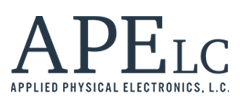INTRODUCTION
Applied Physical Electronics L.C. (APELC) was contracted by the Air Force in 2007 to build a compact wideband source similar in frequency content, field strength, and form factor to the Diehl DS110 suitcase. The desire was to have a domestically available (and constructed) system that could be used to test U.S. assets against threats similar in nature. Because APELC had to start from ground zero on the design of this system, a unique wideband dipole and source topology was developed that has since been utilized on an entire suite of high-powered wideband systems.
APPLICABILITY TO MIL-STDs
As mentioned in our previous blog entry INCREASED EMP THREATS LEAD TO CHANGING TESTING STANDARDS PART 2, many of APELC’s EMP and wideband test systems meet the requirements for several MIL-STDs. The most widely applicable is MIL-STD-464C (or ATDP 2407 specifically for Army systems), which defines an HPM Wideband threat environment in Table A.5 of the standard (shown below). Because of the wideband nature of the environment, the table uses units of mV/m/MHz @ 100 m to define a broad-band electric field distribution for 9 bands covering 30-3000 MHz. APELC works with the customer to determine the best wideband source based upon the following criteria:
- Size of the target/Equipment Under Test (EUT)
- Distance of the EUT from the source
- Desired spectral coverage

Typically, APELC’s customers are DoD test facilities who have these criteria defined from their customer and then pass them on to us. APELC takes this information and determines the best combination of pulsed power, wideband source (resonator) and antenna/reflector needed to illuminate the target in a way that meets the customer’s requirements as well as the MIL-STD. Our sources cover electric field strengths up to 500kV/m and bandwidths ranging from 30 MHz up to 500 MHz. While sources such as the RFSC-400 can be used for testing small test objects to MIL-STD-464C, large test objects requiring multiple bands from Table A.5 of MIL-STD-464C will require the use of either our oil or air-insulated dipole test stand systems. An example of this is shown below.
EXAMPLE: Testing a 6 meter wide vehicle to MIL-STD-464C
For this example the customer is wanting to evenly illuminate a vehicle that is 6 meters wide to bands 2 and 3 from TABLE A.5 (150-400 MHz). The APELC wideband dipole test stand has a beam width of ~75 degrees using our standard corner reflector. Using some simple geometry, the test object would need to be about 4 meters away to fully illuminate the vehicle. For this example we will use 5m to allow for a conservative margin. Table A.5 defines a broadband electric field strength of 7000 mV/m/MHz at 100m, or 700 V/m/MHz at 1m. Therefore at 5m, the illumination level would need to be 140 V/m/MHz. APELC creates field maps for all of our wideband sources that can be used to determine which source or sources best meet the requirement. In this case the 175, 245, and 340 MHz center frequency dipoles cover this spectrum without exceeding a +6dB threshold as shown in Figure 1.

Figure 1 Spectral coverage for the DP175-OIL, DP245-OIL, and DP340-OIL
The APELC wideband test stands utilize one of our Marx generators to pulse charge a resonator circuit integrated into a wideband dipole antenna. Customers have the option of interchanging antennas on a single test stand using one Marx generator, or using multiple test stands if simultaneous coverage across multiple bands is desired. An example of one of APELC wideband dipole test stands is shown below.

Figure 2 Example of an APELC Wideband Dipole Test Stand System
APELC has a suite of off-the-shelf high-powered wideband test products as well as custom products including helical antenna systems.
To find out more, check out our line of high-power wideband RF products at https://apelc.com/high-power-rf/
